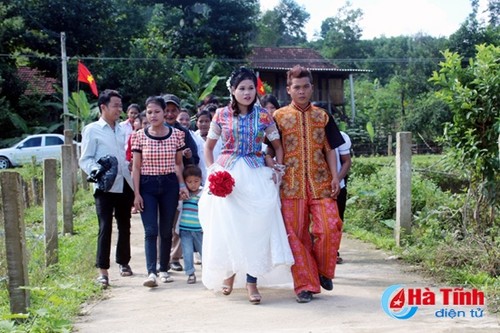 A modern Chut wedding. (Illustrative photo: baohatinh.vn) A modern Chut wedding. (Illustrative photo: baohatinh.vn) |
The book "Flowers on stone mountains – Portraits of ethnic minorities in western Quang Binh" by Nguyen Huu Thong and associates describes the Ruc and Ma Lieng branches of the Chut. When a boy falls in love with a girl, he expresses his love by bringing many bundles of wood to the girl’s house. He wants to show her his love as well as his diligence, responsibility, and maturity.
“The bundles of wood show his ability to create material wealth for a family. He brings firewood to a woman's family, and if the woman's family is impressed, they make a sign and the two families prepare for a wedding. The firewood must satisfy the woman’s family’s expectations. They notice whether the bundles of firewood are big or small and how straight the logs are. The suitor must demonstrate strength, carefulness, and ability when piling up the firewood,” said Dr. Kim Ngoc, who has studied the Chut.
The marriage has many steps – proposal, engagement, and wedding. The uncle of the groom plays an important role in his nephew’s marriage.
“The uncle brings offerings to the woman’s house. The offerings include a big pig for the bride’s father and a smaller pig for the uncle of the bride,” Mr. Ngoc said.
After the wedding the bride stays with her husband’s family. Only the Ma Lieng require the man to stay with his wife’s family during the first 2 years to express his gratitude to his parents-in-law for giving birth to and raising his wife.
“The Chut are dutiful to their parents. When they begin to harvest crops, they prepare a delicious meal to honor their parents if they are still alive. They hand pick the food to feed their parents. It’s a solemn tradition that not all communities practice. Usually it is the eldest daughter-in-law who prepares the ceremony and feeds the parents,” said Mr. Ngoc.
The Ruc were the last Chut people to give up living in caves. After the resettlement campaign began in 1957, the number of people living in caves soon decreased. People moved to simple shacks and then to more permanent houses in Yen Hop and Mo O hamlet.
The Ruc used to believe that when a woman delivers a baby, she must follow certain taboos to avoid offending the deities. A baby was delivered in a temporary hut outside the village and not allowed to enter the village for a certain period of time.
Today, this custom is less burdensome. Dr. Kim Ngoc says the Ruc have a ritual to welcome the mother back to her house.
“Before mother and baby can enter the house, they must bathe in herbal water. The woman may then enter the side room of the house. After a certain period, she is allowed to go into the main hall.” he said.
The daily diet of the Chut includes banana soup and taro powder.
“They also eat steamed cassava cakes. Cassava is pounded, shaped, and steamed. Since ancient times, they have smashed rocks together to make fire. They eat bamboo shoots cooked with snails caught in the spring, boiled bamboo dipped in chili, and grilled fish and shrimps seasoned with chili and pepper,” said Dr. Ngoc.
The Chut collect hundreds of species of edible and medicinal herbs from the forests. Their knowledge of plants is passed from one generation to the next.